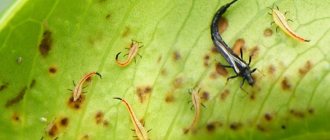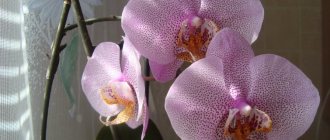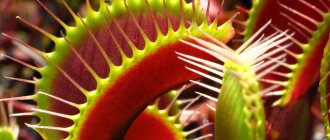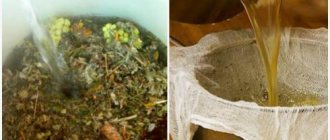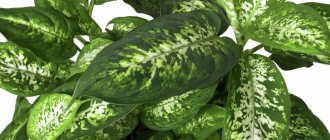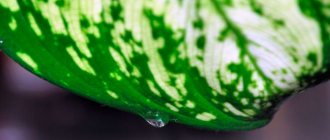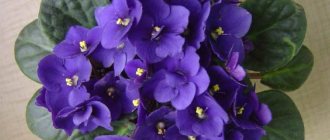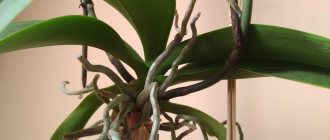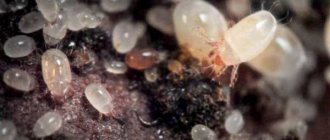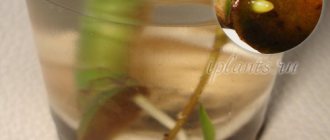Dieffenbachia diseases
date of article: 01/11/2012
Dieffenbachia leaf spot.
Spotting on Dieffenbachia leaves is caused by the fungus Phaeosphaeria eustoma (Fuckel) L. Holm.
Signs of the disease. The lower, older leaves are most damaged, especially along the edges. Small round spots appear on the leaf blade of plants, growing as the disease progresses. The spots have a brown center and an orange border.
The pathogen persists on the remains of infected plants and is transmitted by water. Plants exposed to high air humidity and elevated temperatures are more severely damaged.
Control measures. Maintaining optimal air humidity and temperature conditions. When signs of disease appear, treatment with systemic fungicides is carried out.
Fusarium Dieffenbachia.
Fusarium disease in Dieffenbachia is caused by the fungus Fusarium solani (Mart.) Sacc.
Signs of the disease. Elongated, depressed spots of dark shades appear on the root collar and roots of the plant. As a result of damage to the stems, plants turn yellow and wilt. In case of high humidity of the substrate and air, the damaged areas are covered with light pink mycelium of the fungus.
The pathogen can survive in the soil for a long time, and it is very resistant to external influences.
The spread of the disease occurs with contaminated soil, as well as when the roots of a diseased and healthy plant come into contact. Plants that have a lack of potassium in the substrate, as well as those that are overdried, are especially susceptible to the disease.
Control measures. Use of quality substrates. When cuttings, only healthy material is used; it is recommended to immerse the cuttings in a fungicide solution for about 15 minutes for disinfection. For preventive purposes, spraying with biological fungicides is carried out, for example, Trichodermin (Glyocladin). If a disease is detected, the plants are treated with systemic fungicides, for example, such as Rovral, Fundazol.
Dieffenbachia anthracnose.
Anthracnose in Dieffenbachia is caused by the fungus Colletotrichum gloeosporioides (Penz.) Penz. and Sacc .
Signs of the disease. Quite large spots appear on the leaves along the edge of the leaf blade. As the disease progresses, the leaf dries out as the spots spread over the entire surface of the leaf. The pathogen persists in infected plant debris.
Plants kept at high air temperatures and high air humidity are especially susceptible to the disease. Overmoistening of the substrate also contributes to the disease.
Control measures. Contents taking into account the characteristics of growing the plant. When signs of disease appear, treatment is carried out with systemic fungicides, for example, such as Vitaros, Fundazol.
Dieffenbachia root rot.
The causative agents of Dieffenbachia root rot are species of fungi from the genera Pythium and Phytophthora .
Signs of the disease. Withering of the plant, followed by its death. Depressed dark areas appear on the root collar and on the roots of plants; as the disease progresses, they cover the entire tissue, and in this place the plant rots, breaks and lies down. Light gray fungal mycelium develops on the spots.
The pathogen persists in the soil, from where plants become infected.
Excess fertilizer in the substrate, lack of lighting, poor ventilation, excessive watering, too moisture-intensive substrates, high temperatures - all these factors lead to the fact that the plant is more susceptible to damage by the pathogen. The difference in temperature of the substrate and air, exceeding 6-8 ° C, also contributes to the development of rot.
Control measures. The use of high-quality, well-aerated substrates with a neutral reaction, correct agricultural technology, fertilizing with fertilizers with a high potassium content. If signs of disease appear, watering is stopped, the substrate is partially changed to a new, dry one, and treatment is carried out with systemic fungicides, for example, Profit Gold, Ridomil Gold, Previkur.
Dieffenbachia bacteriosis.
Bacteriosis in Dieffenbachia is caused by the bacterial species Erwinia carotovora subsp. carotovora (Jones) Bergey et al and Erwinia chrisantemi Barras et al.
Signs of the disease. Watery spots with a sharply defined edge appear on the stems of the plant, both above and below the soil. Afterwards the spots become brown or gray in color. Watery spots also appear on the leaves, becoming light brown in color and having a yellow border.
The pathogen persists in the remains of infected plants until they are completely decomposed, and is transmitted through cuttings or due to mechanical damage. The pathogen develops especially actively in conditions of high humidity and temperature, with an excess of nutrients in the soil. Oppressed plants are more damaged by this disease.
Control measures. Compliance with the regime of agricultural technology, destruction of diseased plants, use of clean tools for cutting plants.
Bronzing of Dieffenbachia.
The causative agent of viral bronzing in Dieffenbachia is Tomato spotted wilt virus .
Signs of the disease. The plant has concentric circles, ring-shaped spots, and yellowish arcs appearing on its leaves. As the disease progresses, the leaves wither, burn symptoms appear, and the stems may experience unilateral leaf necrosis on the infected side of the stem. aThe leaves remain hanging on the plant. The plant slows down its growth processes.
The pathogen is carried by pests. In particular, various species of the thrips genus.
Control measures. Timely treatment with insecticidal preparations.
Dieffenbachia mosaic.
Viral mosaic in Dieffenbachia is caused by Dasheen mosaic virus .
Signs of the disease. The growth processes of the plant slow down, and mosaic spots appear on the leaves.
The pathogen persists in infected plants and is transmitted by insect pests, mainly aphids, also with cuttings from diseased plants.
Control measures. Use of healthy plants for propagation, timely spraying of plants with insecticidal preparations.
In our article about Dieffenbachia you can familiarize yourself with its cultivation and various types.
If you have problems with your Dieffenbachia, but you cannot determine what’s wrong with it on your own, you can always contact us for help on our flower forum.
Article prepared by: Marina and Alexander Mityaev
Viral diseases
To answer the question of why Dieffenbachia leaves turn yellow, one should not exclude the possibility of a viral disease. Even with properly organized care, tropical ornamental crops often suffer from leaf bronzing and viral mosaic.
Bronzing of leaves
On the leaves of Dieffenbachia affected by the pathogens of this infection, small ring-shaped spots, yellow arcs and concentric circles appear, which begin to rapidly grow in size. The leaf blade gradually withers, signs of unilateral necrosis are observed on the stems, and growth processes slow down. If you do not take emergency measures to save your home flower, the plant will soon die. Bronzing of leaves is carried by harmful insects, especially thrips.
Viral mosaic
The Dasheen mosaic virus is the cause of the disease called viral mosaic in exotic Dieffenbachia. The main symptoms of this disease include the suspension of growth processes and the presence of mosaic spots on the surface of the leaves. The pathogen of the disease is transmitted by cuttings or insect pests (in particular, aphids), and also persists in previously infected indoor plants.
And now we’ll find out how to deal with viral infections, due to which Dieffenbachia can turn yellow, wither, shed leaves and rot. In the fight against viruses that quickly infect the stems and leaves of indoor plants, you need to act urgently. Modern insecticidal preparations will come to the rescue, among which Aktara and Fitoverm are very popular among gardeners.
Dieffenbachia ailments: how to help cope with them.
Dieffenbachia (lat.) is an evergreen tropical plant, its homeland is the humid forests of Central and South America.
Dieffenbachia can reach two meters in height, the leaves are large, wide, and variegated.
With good, competent care, Dieffenbachia pleases with its exotic beauty, the flower develops well, and new leaves constantly appear. But what to do if your “green household member” gets sick?
Most often, gardeners growing Dieffenbachia are faced with the fact that its leaves begin to turn yellow, dry out and curl, and there are other problems - the flower grows poorly and becomes lethargic.
What is the cause of the malaise: improper care at home or a pest attack? Let's look at all the "sores" of Dieffenbachia in more detail and try to determine the cause of their occurrence and methods of treatment.
Growing conditions
Not everyone may have heard about such a houseplant as Dieffenbachia, but many have certainly seen it. She is not capricious and easy to care for, but her secretions are dangerous for both animals and humans. There are many varieties of the plant, but not all of them are suitable for growing indoors. Caring for Dieffenbachia, first of all, should include creating favorable living conditions for the plant.
Placement and lighting
The first thing to consider is the size of your flower. The plant prefers bright sunlight, but direct sunlight should not fall on the leaves. For variegated varieties, lighting is necessary to ensure that the leaf color is fully revealed. In addition, the lack of light will also affect the size of the sheet.
For small bushes, a window sill on the western or eastern side is suitable; a tall and voluminous plant should be kept on the floor at a short distance from the window. Otherwise, you will need artificial lighting created using fluorescent lamps. In winter, you need to extend daylight hours to normal using lamps. A very important condition is the absence of drafts.
Air temperature requirements
The temperature range depends on the time of year and the growing season of the plant. In the spring-summer period, the optimal temperature will be about +20 °C, maybe a little more, but then care should be taken to increase the humidity level. For winter, the optimal temperature is +16–17 °C. Below this is not advisable, as the plant may shed its leaves. The main thing is to take care of the absence of temperature changes, which can cause stress for Dieffenbachia.
Humidity level
The higher the air temperature in the room, the higher the humidity level should be. Under normal home conditions, with average temperatures, it should be no lower than 65%. The plant gratefully accepts washing and spraying, but provided that the room temperature is not lower than +18 °C.
It is recommended to wipe large leaf plates frequently with a wet cloth and systematically rinse them in the shower. You can slightly raise the humidity level by using wet sand, moss or gravel in the container with the plant. A humidifier or an artificial waterfall will also help to cope with this task.
Dieffenbachia diseases and their treatment
How to help a tropical beauty?
- Dieffenbachia leaves turn yellow, reasons, what to do? Solution to the problem:
- low air humidity. Dieffenbachia, not receiving enough moisture from the air, also begins to turn yellow, so in winter it should be kept away from central heating radiators or buy an air humidifier;
- direct sunlight, there should be enough light;
It is necessary to check whether the roots of the flower have actually begun to rot. To do this, you need to remove the plant from the pot, inspect the root system, remove rot and affected areas of the root, transplant the flower into another smaller container, observing the planting rules (drainage 1/3 of the pot, 2/3 soil mixed with sand and peat)
- low air temperature. Dieffenbachia is a tropical resident, it loves warmth, so the temperature in the room should not fall below 22 degrees;
- drafts, which the flower really does not like, so it is better to keep Dieffenbachia away from the balcony door and windows;
- Dieffenbachia dries and its leaves fall off, the tips of the leaves dry and wither, causes and solution to the problem:
- fungal infections (atracnose, leaf spot), fungal spores (leaf spot) can be obtained by the plant with irrigation water; dry brown spots appear along the edges of the leaves, gradually spreading over the entire surface of the leaf, it becomes lethargic and lifeless.
- drafts, low air temperatures can also lead to leaves drying out and falling off; to eliminate the Dieffenbachia problem, you need to ensure a comfortable microclimate in the room;
- the plant ages, the lower leaves dry out and fall off, this is a natural process. It is necessary to rejuvenate it by cuttings. To do this, the bare trunk of Dieffenbachia needs to be cut into cuttings, leaving only a small part of the stem in the pot, which will soon give rise to a new shoot and Dieffenbachia will continue to grow;
- root rot, which appears when the soil is overly fertilized and moistened. Rot first affects the root system, then gradually affects the trunk, the flower withers and dies. It is necessary to replant Dieffenbachia, having previously treated the roots with a fungicide and limit watering;
- overmoistening in combination with low air temperature, in this case it is necessary to provide the plant with a comfortable temperature and limit watering.
Athracnose is provoked by excessively high temperature in the room, dry air, in some cases, waterlogged soil (excessive watering); to get rid of this problem, it is enough to normalize the temperature and watering regime; the affected leaves can be treated with a regular fungicide to prevent infection of other leaves;
To combat fusarium, the flower must be transplanted into another pot, after removing rot from the roots and treating the affected areas with a fungicide;
- When watering with cold water, it is advisable to leave the water for irrigation for at least 24 hours;
- drafts and low room temperature;
- pest attack.
- viral lesions (bronzing and viral mosaic), usually carried by insects, yellow round spots (bronzing) or a mosaic of spots (viral mosaic) appear on the leaves of the plant, Dieffenbachia withers and stops developing. It is almost impossible to cope with such a problem; the flower must be destroyed;
- there is not enough light. You need to move the flower to a brighter room, but remember that the flower does not tolerate direct sunlight;
- insufficient watering. The soil in the pot should always be slightly damp;
- lack of fertilizers in the soil. The lack of fertilizers, as well as their excess, negatively affects the growth and development of Dieffenbachia; the fertilizer must be used strictly according to the instructions indicated on the packaging;
- excessive watering. The flower protects itself from excess moisture in the soil; a similar phenomenon can be observed before rain; the plant opens channels for moisture to escape, preparing for an excess of water.
In the photo below you will see the symptoms of the disease in Dieffenbachia:
Flower care
Growing a healthy specimen of Dieffenbachia is not difficult. The plant is considered quite unpretentious, but without the correct conditions of maintenance and watering it stops developing, withers and may die.
Lighting
Indoor varieties of Dieffenbachia need good lighting, but direct sunlight burns the green mass. Varieties covered with a decorative pattern are especially vulnerable. Plants with a single color are less demanding on lighting, so they can be located much further from color sources.
Temperature
The optimal level of plant maintenance varies from +15 to +30 degrees. The wide color range allows you to keep the flower on closed verandas, loggias, and balconies.
Dieffenbachia must be protected from drafts. Cold air negatively affects the condition of the flower, which quickly sheds its leaves. A drop in temperature below +15 degrees causes the death of the plant.
Humidity
Growing the crop requires a warm and humid microclimate. To compensate for excessive dry air, damp moss, sand, gravel or a container of water are placed on the tray.
In the warm season, the flower is periodically sprayed, and at temperatures below +18 degrees, wiped with a damp cloth. Once a week, the plant is given a hygienic shower.
Watering
Maternity crops from the tropics need a lot of moisture. Abundant and frequent watering requires good drainage. Otherwise, the water will begin to stagnate at the roots. Prolonged drought leads to the death of Dieffenbachia, so it is impossible to leave the flower without watering for a long time.
In winter, watering is reduced, but the earthen clod is not allowed to dry out. Otherwise, the flower will stop growing and developing. Only distilled water is used. The best liquid is considered to be passed through a filter.
Priming
The tropical ornamental foliage plant is grown in a special substrate for Dieffenbachia or representatives of the Araceae family. To prepare soil with neutral acidity at home, mix together:
- 4 parts of turf land;
- 1 part peat;
- 1 part sand;
- 1 part leaf soil.
To improve the composition of the substrate, brick chips or charcoal are added to the mixture. The introduction of a small amount of bone meal during planting allows you to enrich the soil with nutrients.
Circumcision
Dieffenbachia is characterized by rapid growth and many specimens need height adjustment. Pruning is recommended when the plant loses its lower foliage, which indicates natural aging. To stimulate young shoots to grow, the top part is cut off about 20 cm below the node.
Pruning is carried out with a disinfected pruner or sharp scissors, but in compliance with certain safety measures. The protruding milky sap burns the skin and mucous membranes, so pruning is carried out wearing gloves and safety glasses. The cut areas are dipped with a napkin and sprinkled with crushed activated carbon.
Top dressing
The evergreen plant is fertilized in spring and autumn. Varieties with completely green leaves are fed once every 10 days. It is necessary to use preparations that do not contain lime. Fertilizers are diluted twice as strong as indicated in the instructions.
It is better to feed variegated varieties with mineral fertilizers. The use of organics leads to the loss of the decorative pattern on the leaf plate. The frequency of enriching the soil with such fertilizing is every 20 days.
Transfer
Dieffenbachia is transplanted into a new pot when the old pot becomes too small for the overgrown rhizome, the ends of which begin to be visible in the drainage holes. The event is best held in the spring. If the crop is growing too actively, summer replanting may be required.
The new container is taken 3-4 centimeters deeper and wider. To avoid damaging the roots, the flower is replanted using the transshipment method. A drainage layer is laid out at the bottom of the pot, Dieffenbachia is placed with a lump of earth, and a nutrient substrate is poured around the edges. The plant is not fertilized for a month after transplantation, but abundant watering is provided.
Reproduction
Dieffenbachia, grown at home, blooms extremely rarely, so seed propagation is not used. It is much easier to obtain a new specimen from cuttings or aerial shoots.
Cuttings are separated with at least one node and leaf. The shoot is left for a day without water. The cuttings are laid horizontally on the ground and covered with film. When the plant sprouts shoots, the pot is moved to a permanent place, watered and fed in the same way as an adult specimen.
Alternatively, the cut stem is placed in water until roots form and then the cutting is transplanted into a container. The disadvantage of this method is that Dieffenbachia grows asymmetrical.
Dieffenbachia: pruning and rooting. My experience
The evergreen bush is propagated by aerial cuttings by making a cut on the stem, onto which damp moss is applied, and covered with an opaque film on top. New shoots appear slightly below the incision. They are removed and rooted in the ground.
Pests. Methods to combat them
Despite its poisonous nature, Dieffenbachia is susceptible to attacks by pests, which cause significant harm to it.
It is most often affected by spider mites, aphids, mealybugs, and scale insects. The method of combating each species is the same: it is necessary to wash the leaves and the trunk of the flower with a sponge soaked in soapy water (which should later be washed off under running warm water) and treat Dieffenbachia with an insecticide solution (karbofos, 15 drops per 1 liter of water).
- scale insect is a small insect with a hard waxy body, it can usually be found on the inside of the leaf; the affected leaves turn pale and fall off;
- the mealybug got its name due to its secretions that look like shreds of fluff, it attacks the leaves, Dieffenbachia begins to turn yellow and fall off, the flower dies;
- spider mite, the presence of which can be determined by a coating of cobwebs on the trunk, the leaves of the flower become sluggish and lifeless;
- aphid is an insect that has a dark green color, it can be seen on the inside of the leaves, aphids are dangerous because they are able to suck out intercellular fluid, weakening the plant and are a carrier of diseases;
- thrips are small beetles that suck the juice from the plant, which leads to curling and drying of the leaves.
World is Small
Diseases and Pests of Dieffenbachia
Despite the fact that the plants are poisonous, they are often attacked by pests.
The most common:
Spider mite, a sign of damage to which is the presence of cobwebs in the internodes of the trunks, sluggish and falling leaves.
Thrips, small (1-2 mm) bugs that suck the juices from the plant, which leads to stunted growth, curling and drying of the leaves.
Aphids, numerous colonies of which not only weaken plants by sucking out intercellular fluid, but are also carriers of various diseases.
The appearance of spider mites, thrips and aphids on Dieffenbachia is especially favored by dry indoor air (relative humidity below 60%).
Scale insects and false scale insects, which suck the juice from leaves and stems, leaving a characteristic discharge, brown plaques that are difficult to remove. The leaves become discolored, dry out and fall off.
Mealybugs, insects 3-6 mm in size, attack leaves, stems and flowers, which are covered with a white mealy coating. The leaves become deformed and dry out, which can lead to the death of the entire plant.
Measures to combat all of the listed Dieffenbachia pests are similar; they consist of their mechanical removal using a sponge and soap solution, followed by rinsing under running warm water, and treatment, if necessary, with insecticidal preparations, actellik or karbofos, at a concentration of 15 drops per liter of water.
Diseases and pests found on Dieffenbachia, plant treatment
Healthy Dieffenbachia grows very intensively and has bright leaves that, in size and color, correspond to their varietal characteristics. If the plant loses its original attractive appearance, it means that it is sick or pests have settled on it.
As a rule, this is caused by improper care. Therefore, before purchasing this flower, you need to study the signs of various diseases that affect it, how to treat them and how to avoid infection.
Curling and drying of leaves, how to protect Dieffenbachia from thrips
One of the many dangerous pests for Diefenbachia is thrips, since their reproduction is not affected by temperature fluctuations.
The thrips body is narrow with two pairs of wings, 1.5 mm long. The color of thrips is black or brown, the larvae are yellow.
Dieffenbachia affected by thrips becomes discolored and covered with gray spots. Soon the leaves turn brown and fall off.
These sucking pests (both adults and larvae) cause the main damage to flower stalks, which become covered with streaks and become distorted.
In addition, the plant becomes covered with a sticky black substance, on which sooty fungus may appear. To combat this type of insect, the use of flycatchers and spraying with insecticides will be effective.
Main diseases of Dieffenbachia
Dieffenbachia can be affected by fungal, bacterial and viral diseases. The most common of them include those listed below, and the photos accompanying the article will help you recognize them.
Leaf spot
Leaf spotting causes the formation of brown spots on the edges of the plant's foliage, which are surrounded by an orange border. Then they spread to the entire leaf blade. The disease can develop due to high temperature and humidity in the room and waterlogging of the soil. It is necessary to treat the plant with a fungicide and review the conditions of maintenance.
Anthractosis
With anthractic disease, light brown spots with a dark border appear on the leaves and stems of Dieffenbachia, which merge over time and the foliage dries out. It occurs for the same reasons as leaf spot and is also transmitted from infected plants . Treatment is also carried out by spraying with a fungicide.
Fusarium
With fusarium, the root system and root collar of the plant are damaged. Elongated spots of dark brown color appear on them, covered with mycelium of the fungus with a light pink color. Dieffenbachia turns yellow and withers.
The disease develops in overdried soil, as well as with a lack of potassium fertilizers. Dieffenbachia needs to be removed from the pot, the roots should be washed from contaminated soil and replanted into a clean container with healthy soil. Then spray and water with a fungicide solution, and then fertilize with appropriate fertilizers.
Root rot
If the leaves of a Dieffenbachia plant have wilted and turned yellow or brown, it is highly likely that it is infected with root rot.
In this case, you need to dig up the soil to a depth of fifteen centimeters and check the root system; if the roots turn black and emit an unpleasant odor, it means that Dieffenbachia is infected with this particular disease. It is caused by waterlogging, excessive fertilizing or contaminated soil. The plant needs to be replanted, removing rotten roots, treating with a fungicide and reducing watering.
Bacteriosis
With bacteriosis, watery spots with clear boundaries form on the leaves and stems of Dieffenbachia. Then they acquire a brown or brown color. The development of the disease can be triggered by high temperature and humidity , and excessive feeding. Bacteriosis can also be introduced through cuttings or contaminated soil. It is necessary to spray and water the plants with preparations containing copper (Bordeaux mixture, copper sulfate and others).
Bronzing of Dieffenbachia
Bronzing of Dieffenbachia can be determined by the presence of yellow circles (rings) on the leaves. Over time, they begin to wither and the plant slows down. The disease is usually caused by pests, which are destroyed by spraying with an insecticide.
Viral mosaic
When infected with viral mosaic, Dieffenbachia stops developing, and spots in the form of stars and rings appear on the leaves. The disease is also caused by the presence of pests, which are destroyed by insecticides. Plants that are too affected must be destroyed.
Problems caused by improper care
When breeding Dieffenbachia, the following problems and questions may arise:
- Why does Dieffenbachia turn yellow, and what needs to be done? The leaves of Dieffenbachia turn yellow most often when it is kept at low air temperatures in winter, in the presence of drafts, insufficient fertilizing, and if hard water is used for irrigation. If the lower leaves turn yellow and the top is actively growing, then the plant needs to be transplanted into a container with a larger volume.
The tips of Dieffenbachia leaves turn yellow and dry out when infected with root rot, due to temperature changes, dry air and severe waterlogging of the soil. If the leaves turn yellow and cobwebs form on their lower surface, this indicates the presence of a spider mite on the plant;
If you want to know why anthurium does not bloom, then you need to read this article.
The most common diseases of gardenia and methods of their treatment are described here: https://cvetolubam.ru/gardenia-bolezni/
- Now let's figure out why Dieffenbachia leaves dry out. If the old leaves of a plant dry out, this is a natural process of their life. In this case, you need to cut off and root the top. If Dieffenbachia dries along with new leaves, this may indicate low air temperatures, drafts and insufficient watering
- Dieffenbachia is withering. This may indicate an excess of light and direct rays of the sun hitting the plant; shading is necessary. This also happens if the pot has become too small ; you need to transplant it into a larger container;
- White spots on the leaves with a cottony coating. This indicates that the plant is infested with mealybugs. It is necessary to wash the Dieffenbachia with a soapy solution and spray it with an insecticide;
- If new leaves of Dieffenbachia curl or do not unfold, this may indicate that watering is carried out using too cold water, the room temperature is low and there are drafts. In some cases, this indicates pest damage to the plant;
- The stem and foliage soften and rot. This indicates overwatering of the soil, as well as a low temperature. The affected areas must be removed by treating the sections with activated carbon or sulfur. Next, you need to provide the plant with appropriate conditions. If the damage is too severe, you can try cutting off the top and rooting it;
- The fact that the tips of Dieffenbachia leaves turn brown is caused by insufficient watering and low air temperatures;
- Leaves become discolored. This happens when the Dieffenbachia is exposed to direct sunlight or, conversely, indicates a lack of light. This may also indicate an excess of nitrogen fertilizers in the soil and a lack of phosphorus and potassium fertilizers;
- The leaves become small. This indicates a lack of lighting.
Since many problems can arise when growing Dieffenbachia, and it is quite susceptible to many diseases and pest damage if not properly maintained, it is better to properly care for it than to then engage in long-term treatment, which does not guarantee that it can be saved.
Article rating:
Dieffenbachia diseasesLink to main publication
Related publications
- How to plant Dieffenbachia Is Dieffenbachia poisonous or not Dieffenbachia has bloomed signs Dieffenbachia leaves are turning yellow what to do Reproduction of Dieffenbachia by the tip How to propagate Dieffenbachia Dieffenbachia care at home Replant Dieffenbachia Dieffenbachia harm Dieffenbachia bush care at home Dieffenbachia flower Types of Dieffenbachia
Other problems encountered when growing Dieffenbachia
In addition to the pests and diseases listed above, Dieffenbachia may suffer from improper care and unsuitable living conditions. Let's look at some questions that often arise among amateur gardeners.
Why does Dieffenbachia turn yellow? Most often, the reason for this behavior is low air temperature in winter or drafts, as well as a lack of nutrients and watering with hard water. Yellowing of the lower leaves with intensive growth of the top usually signals that the flower needs to be transplanted into a larger pot. Dieffenbachia leaves also turn yellow when affected by root rot.
Why do Dieffenbachia leaves curl? This usually occurs when attacked by pests, also when watering with cold water, drafts and low temperatures.
Why does the stem become soft and rot? The reason is waterlogging combined with low air temperatures. If the decay is small, you can try to remove it by covering the cut with activated charcoal or charcoal; if it is large, cut off the flower and root the top.
Why does Dieffenbachia dry out? If old leaves dry out, then this is a natural process; if the decorative effect is lost and the stem is exposed, the Dieffenbachia is rejuvenated by cutting off and rooting the top. If young leaves dry out, the cause may be dry soil, cold air, or drafts.
